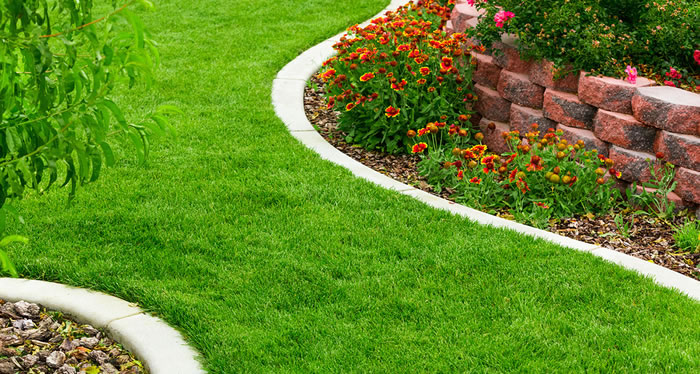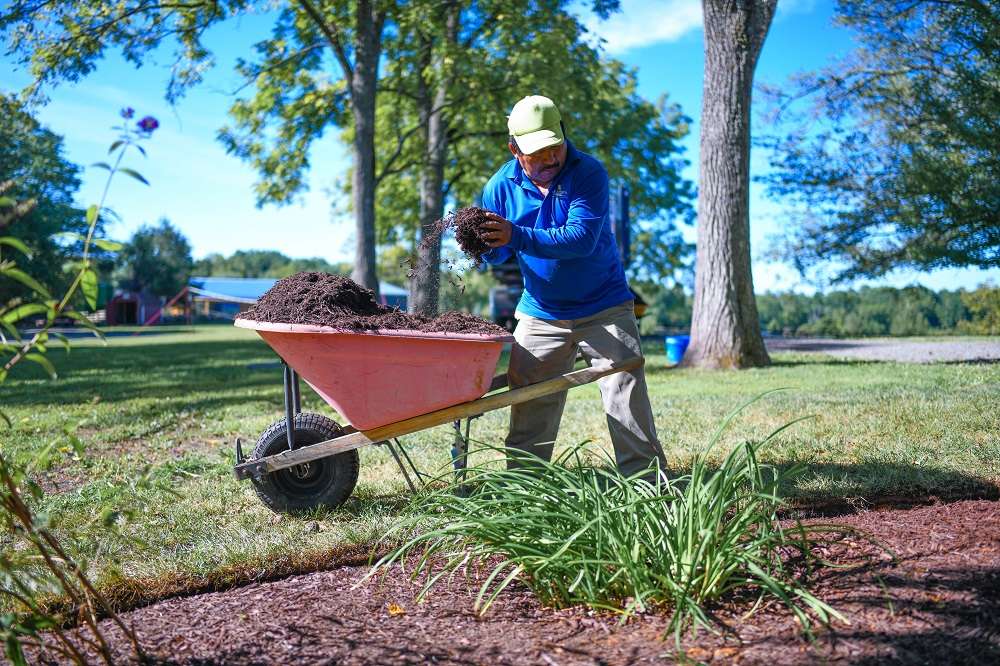Understanding the Comprehensive Range of Works in Expert Landscape Design Services
The extensive range of expert landscape design services incorporates a variety of basic elements. It consists of landscape design concepts, plant choice, and hardscaping functions. Additionally, it addresses irrigation systems and upkeep strategies. Each aspect plays an essential duty in creating practical and cosmetically pleasing outside rooms. Recognizing exactly how these components work with each other can expose much about the art and science of landscaping. The trip right into this intricate field is simply starting.
Landscape Layout Concepts
Reliable landscape layout principles are essential for developing harmonious outside spaces that boost both aesthetic allure and capability. These principles lead the arrangement of components within the landscape, making certain a natural visual experience. Trick components consist of balance, which distributes aesthetic weight evenly; proportion, which relates the size of different components per other and the space; and unity, which creates a sense of wholeness through constant themes and materials.
Emphasis routes interest to focal factors, while rhythm develops movement through rep of layout attributes. The reliable use of line can create paths and assist the eye through the landscape. Additionally, recognizing the website's topography, climate, and existing features is important for assimilation with the surrounding environment. By sticking to these fundamental concepts, landscape designers can craft spaces that not only look enticing however additionally serve their designated purpose, boosting the overall experience for customers.
Plant Option and Installation
In the domain name of specialist landscape design, plant selection and installment play a critical function in accomplishing a prospering garden - landscaping. Highlighting native plant benefits, seasonal factors to consider, and the details dirt and sunlight demands of each types ensures a sustainable and cosmetically pleasing landscape. Careful planning in these locations not only enhances biodiversity yet also advertises long-term eco-friendly wellness
Indigenous Plant Advantages
Why should home owners think about native plants for their landscaping projects? Indigenous plants offer numerous benefits that boost both aesthetic appeals and environmental sustainability. They are well-adapted to neighborhood environments, requiring less water and upkeep compared to non-native species. This resilience lowers the requirement for chemical plant foods and chemicals, advertising a much healthier community. Furthermore, indigenous plants provide environment and food for regional wildlife, including pollinators, which can raise biodiversity in houses. Their experience with neighborhood dirt and weather also results in far better growth rates and durability. By picking native plants, home owners not just produce visually attractive landscapes but additionally add to ecological preservation, making a favorable impact on their local environment. Consequently, indigenous plants stand for a smart choice for landscape design tasks.
Seasonal Plant Considerations
Homeowners who have embraced native plants in their landscape design can better enhance their outdoor spaces by considering seasonal plant choices. By incorporating plants that grow in particular periods, they can develop dynamic and visually enticing landscapes throughout the year. Springtime may usher in vibrant blooms like tulips and daffodils, while summer can display rich foliage and vibrant perennials. Fall introduces a scheme of warm tones with goldenrods and asters, while winter can be emphasized with evergreens and decorative grasses for appearance. Professional landscaping companies frequently recommend selecting plants that not just enhance existing native varieties yet likewise give year-round passion and assistance regional wildlife. This thoughtful strategy to seasonal plant choice ensures a consistently advancing and lasting yard environment.
Dirt and Sunlight Demands
Effective landscape design rests on understanding the details dirt and sunshine demands of plants. Different varieties grow under varying conditions, needing a mindful evaluation of both factors throughout the selection process (landscaping). Soil kinds, such as sandy, clay, or fertile, impact drainage, nutrient accessibility, and origin advancement. In addition, pH levels can affect plant wellness, necessitating dirt testing to establish suitability. Sunshine needs differ substantially; some plants flourish completely sun, while others favor partial or full color. A professional landscaping company thinks about these components to guarantee peak development and aesthetic charm. By straightening plant choices with the setting's particular qualities, landscapes can accomplish sustainability, resilience, and aesthetic harmony, inevitably causing effective plant establishment and lasting maintenance
Hardscaping Features and Construction
While landscape design often stimulates photos of lush plant and lively blossoms, hardscaping functions play a vital function in specifying outdoor areas. These components, which consist of patios, sidewalks, keeping walls, and attractive stonework, give framework and performance to gardens and lawns. Hardscaping utilizes products such as concrete, brick, wood, and stone, permitting varied layouts that complement the all-natural landscape.
The building of hardscaping features requires careful planning and implementation to ensure resilience and visual charm. Professionals analyze website conditions, drain, and spatial relationships to produce view publisher site cohesive exterior atmospheres. Appropriate installment techniques are critical, as they avoid concerns like disintegration and shifting with time.
Including hardscaping not only enhances the aesthetic interest of a home but also assists in exterior activities, making it a fundamental facet of thorough landscaping services. Ultimately, thoughtful hardscaping adds to both the capability and appeal of outdoor spaces.
Irrigation Systems and Water Administration
Reliable watering systems and water management are vital components of professional landscaping, as they guarantee that plants receive the required hydration for ideal growth. These systems can differ from easy drip irrigation setups to innovative computerized lawn sprinkler, created to fulfill the specific needs of diverse landscapes. Proper water management not just maximizes water use, reducing waste, however also improves plant health and wellness and lessens illness dangers.
Landscape design professionals analyze numerous factors, consisting of soil kind, plant species, and local climate, to develop customized watering solutions. Furthermore, integrating rain harvesting techniques can additionally enhance sustainability and effectiveness (Read More). Regular maintenance of irrigation systems is important to preserve functionality and stop leakages, which can bring about water loss and raised prices. Ultimately, a properly designed irrigation system plays a critical role in preserving the aesthetic charm of outside areas while advertising ecological stewardship within professional landscape design methods
Yard Care and Upkeep Approaches
Lawn care and maintenance approaches are basic for achieving a lavish, healthy yard that improves the overall landscape. These approaches incorporate various methods targeted at advertising excellent growth and aesthetic charm. Regular mowing is essential, as it urges thick, also development while avoiding weeds from establishing. Additionally, proper fertilizing offers essential nutrients, with applications tailored to the specific yard kind and soil problems.
Watering methods should focus on deep, irregular irrigation to motivate origin growth, while aeration boosts soil framework and advertises nutrient absorption. Insect and condition management is additionally important; determining issues early permits reliable therapies that reduce damage.
Overseeding can rejuvenate slim or broken yards, improving thickness and shade. By implementing these targeted grass treatment methods, landscaping specialists can assure that backyards continue to be healthy and balanced and vivid throughout the periods, substantially contributing to the general charm of the home
Seasonal Landscape Care and Maintenance
As the periods modification, correct landscape treatment becomes important for keeping the wellness and elegance of outdoor areas. Each period offers unique challenges and demands. In springtime, landscape specialists concentrate on pruning, growing, and feeding to motivate development. Summer season needs routine watering, weed control, and parasite administration to secure newly established plants.
Fall requires the preparation of yards for winter months, consisting of mulching, fallen leave removal, and the growing of bulbs for the following spring. In addition, winter treatment involves shielding at risk plants from frost and guaranteeing that hardscapes are useful and risk-free.
Throughout the year, seasonal landscape upkeep warranties that exterior locations stay aesthetically appealing and healthy and balanced. Professional services can provide customized maintenance strategies that adapt to the details needs of each season, enabling homeowner to enjoy vivid landscapes year-round. Generally, seasonal care is an essential aspect of expert landscape design that advertises longevity and aesthetic value.
Lasting Landscape Design Practices
An expanding variety of building owners are welcoming lasting landscaping practices to create environmentally friendly outdoor areas. These techniques concentrate on conserving sources, enhancing biodiversity, and decreasing ecological effect. Native plants are commonly chosen for their low tide requirements and compatibility with regional environments, lowering the requirement for chemical fertilizers and chemicals. Rain yards and permeable paving are utilized to manage stormwater runoff, promoting groundwater recharge and reducing erosion.
In addition, lasting landscape design integrates natural gardening methods that prioritize soil health and wellness and promote all-natural bug control. Efficient watering systems, such as drip watering and rain harvesting, aid enhance water usage. Furthermore, landscape developers progressively support for using recycled materials, such as redeemed wood and stones, to reduce waste. By embracing these lasting practices, homeowner not only add to eco-friendly conservation yet also produce cosmetically pleasing environments that can love minimal upkeep.
Regularly Asked Inquiries
How much time Does a Landscaping Project Usually Require To Total?
Commonly, a landscaping job can take anywhere from a few days to several weeks to complete, depending upon the task's intricacy, style, and dimension demands. Read More. Elements such as weather condition and source availability likewise influence timelines
What Factors Influence the Price of Landscaping Services?
Various factors influence landscaping solution expenses, including job dimension, design intricacy, material high quality, labor costs, geographical location, and seasonal demand. Each component contributes distinctly to the total economic demands of a landscaping task.
Are Landscape Design Services Available Year-Round?
Landscaping services are usually readily available year-round, although availability may differ based on region, seasonal climate condition, and specific solution offerings. Some services could be restricted throughout extreme weather condition or off-peak periods.
Do Landscape Design Firms Deal Service Warranties on Their Job?

Can I Layout My Landscape Without Professional Assist?
Yes, people can develop their landscapes without professional aid. Nonetheless, they might do not have expertise in plant selection, design, and ecological considerations, potentially leading to much less reliable layouts that might require pricey changes later on.
